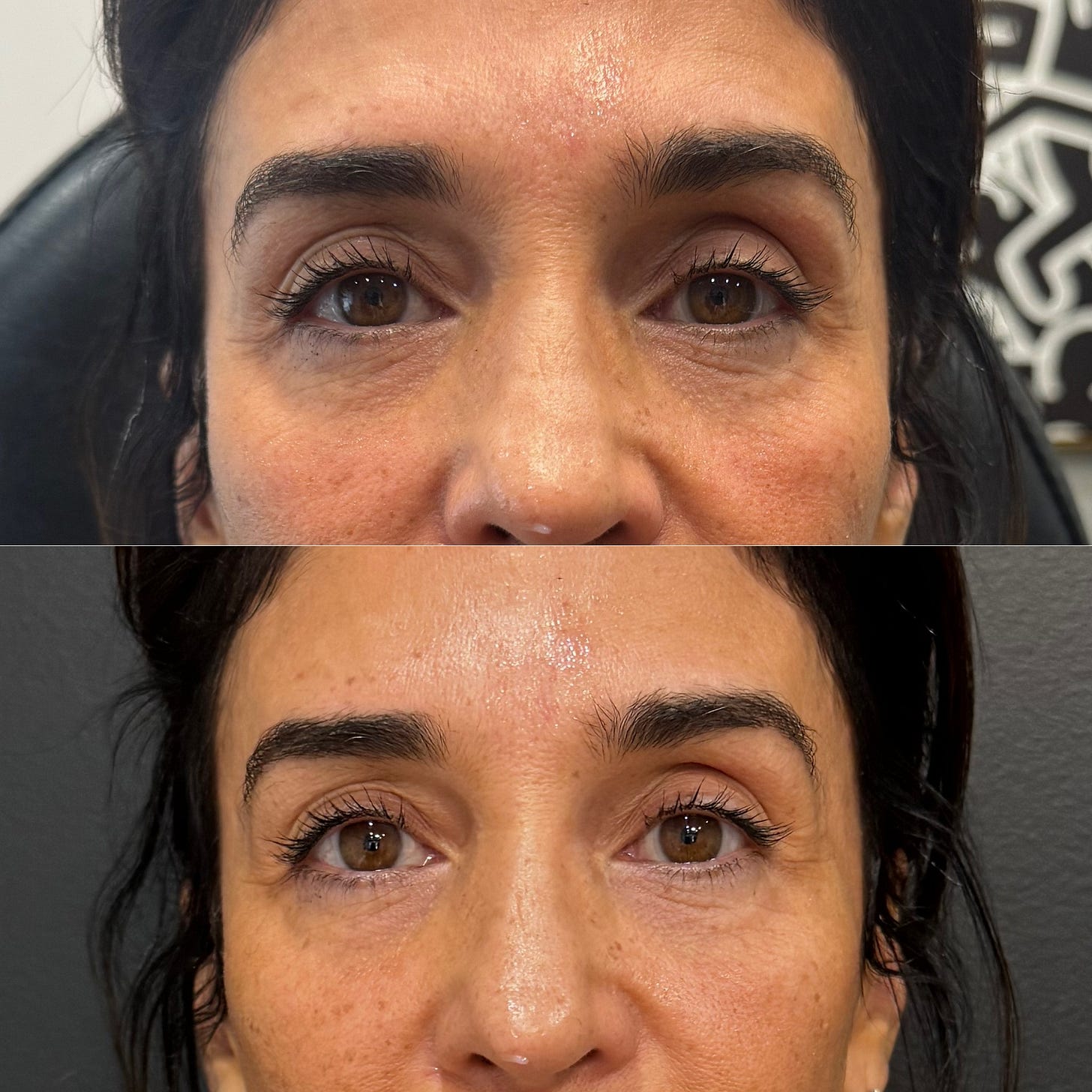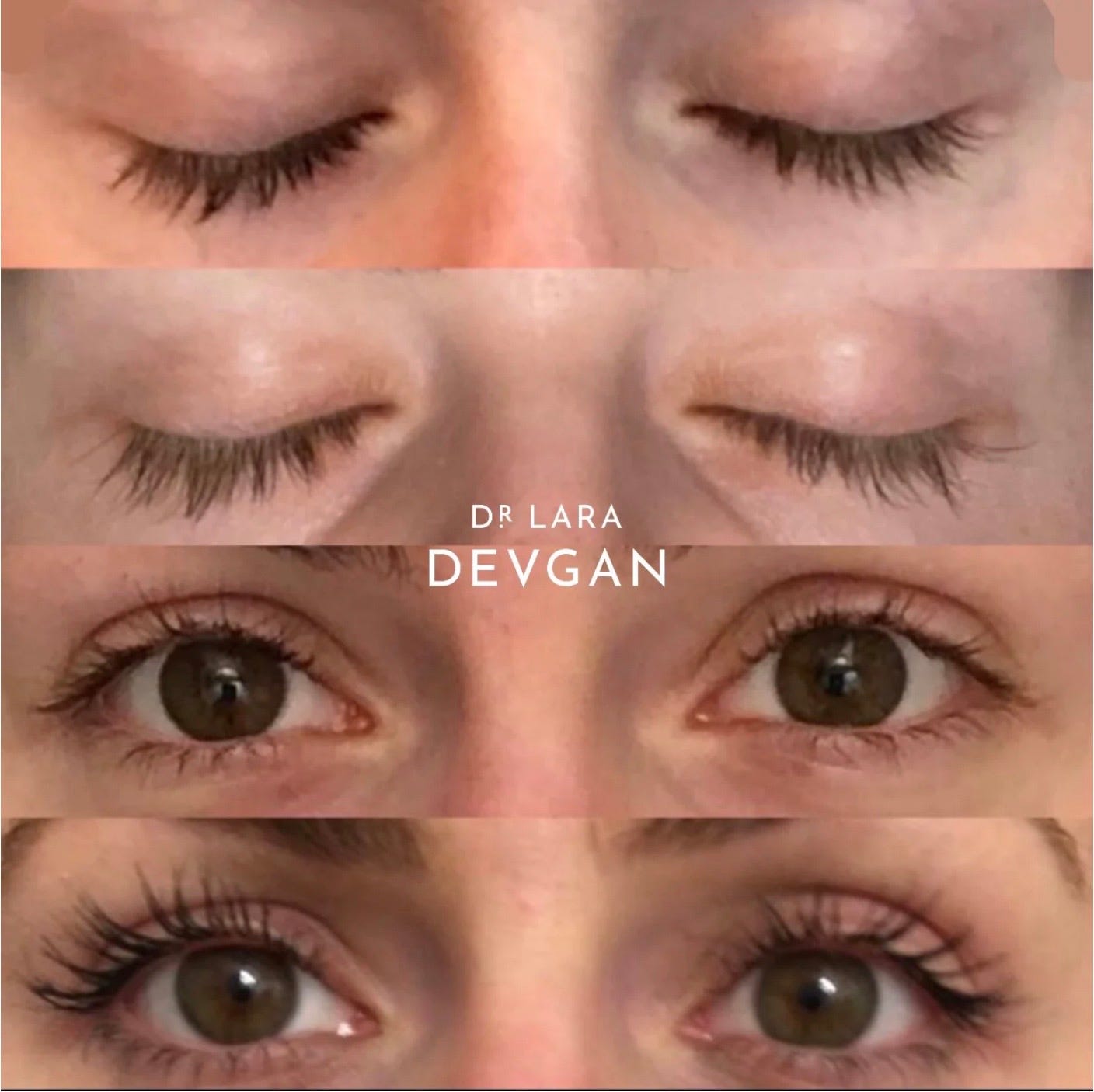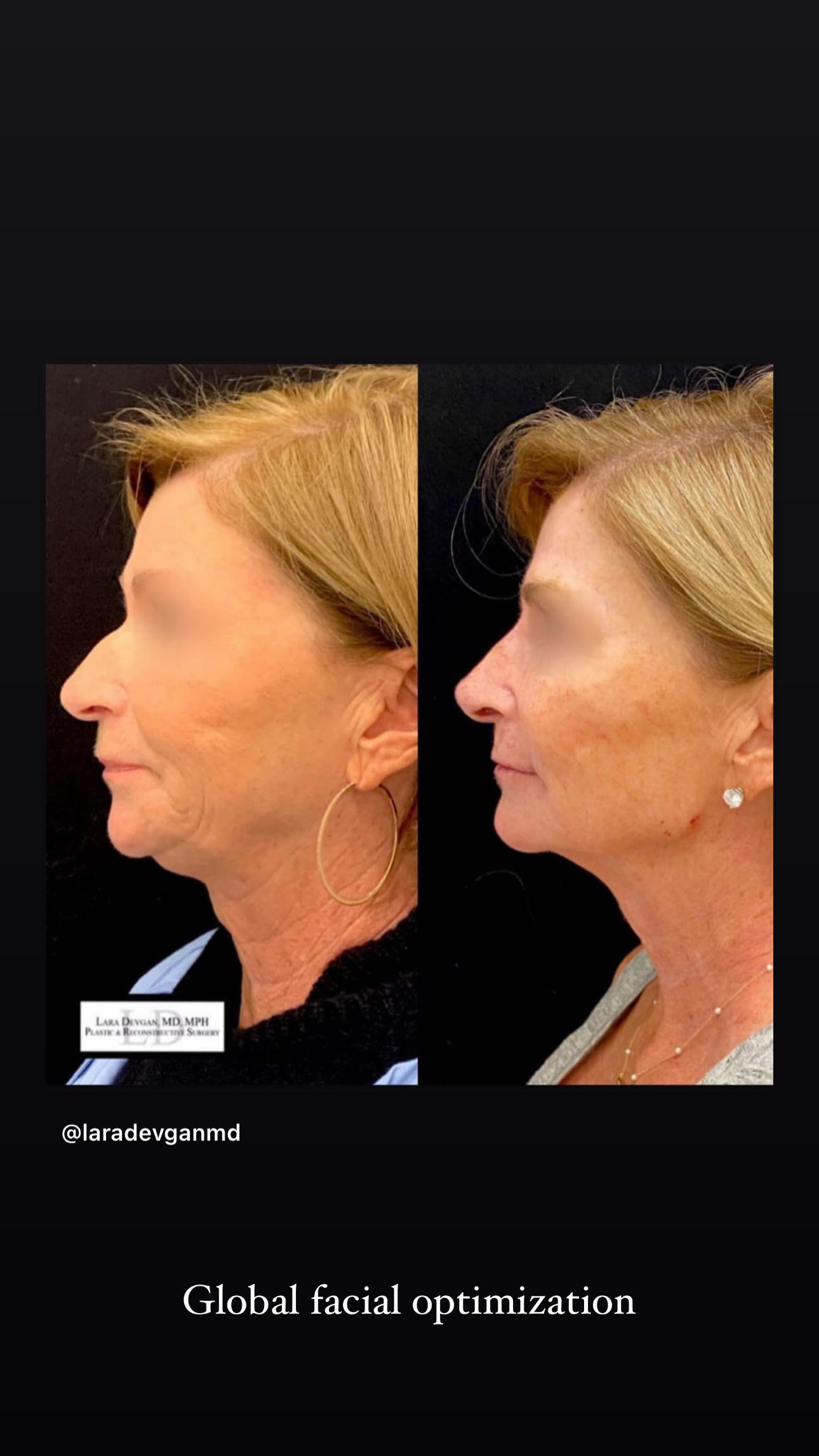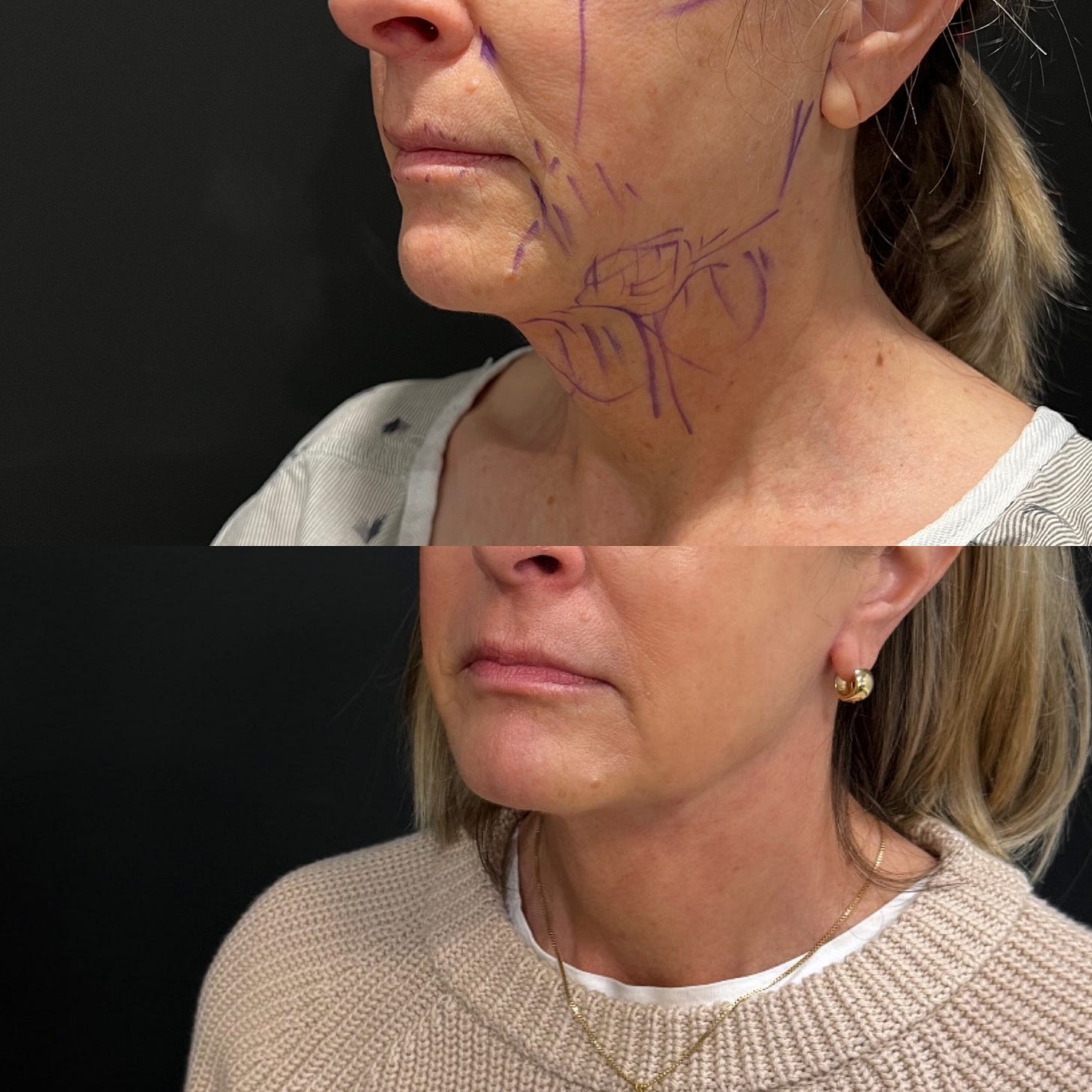The Peri-Menopausal Beauty Blueprint
A Plastic Surgeon's Strategic Approaches to Skin, Bone, and Collagen Resilience
Emerging research reveals that peri-menopause can begin as early as the mid-30s to early 40s, much earlier than previously assumed, prompting a need for earlier proactive health and beauty strategies.
As women transition into the peri-menopausal phase, the body begins to signal subtle yet powerful changes that extend far beyond simple “aging.” From collagen depletion to bone density shifts, peri-menopause calls for a nuanced approach to beauty and wellness—one that combines strategic skincare, targeted aesthetic adjustments, and proactive health measures. Let’s examine the key interventions that not only help maintain our physical vibrancy but also support resilience from within.
Tear trough augmentation and neuromodulator by Dr. Lara Devgan, MD, MPH, FACS
Hormone Replacement Therapy (HRT): A Foundation for Skin and Bone Vitality
Hormone Replacement Therapy (HRT) has evolved into a sophisticated tool, providing tailored support for women experiencing the fluctuations of peri-menopause. By replenishing estrogen levels, HRT helps preserve skin thickness and elasticity, counteracting the inevitable collagen loss that begins around this phase. Recent studies show that HRT may increase skin thickness by up to 30% within several months (Fournier et al., 2019), enhancing the skin’s structural integrity. Beyond aesthetics, HRT significantly impacts bone health, with data indicating a 50-70% reduction in vertebral fractures among women undergoing therapy (North American Menopause Society, 2020).
This dual benefit to skin and bone health makes HRT a strong contender in the anti-aging toolkit, yet it’s essential to approach HRT under expert guidance to balance benefits against individual health considerations.
Topical Estrogen Creams: Localized Support for Skin Quality
For those seeking a localized intervention, topical estrogen creams offer a scientifically-backed alternative that directly benefits the skin without systemic hormone exposure. By increasing skin hydration by up to 20% and supporting collagen production (Bolognia et al., 2018), topical estrogen has emerged as a potent option for managing the thinning and dryness commonly experienced during peri-menopause. When applied consistently, these creams can create a visible improvement in skin resilience, particularly when paired with antioxidant and barrier-repair ingredients.
Dr. Lara Devgan Platinum Long Lash real client results (before and after, eyes closed, and before and after, eyes open)
Retention of Hair, Eyelashes, and Eyebrows
As hormone levels shift during peri-menopause, hair thinning and lash loss often become more noticeable, but targeted treatments can help preserve both. Oral low-dose minoxidil has gained attention as an effective option for combatting hair thinning; at a lower dose than traditional topical applications, it can promote hair regrowth without significant side effects. Studies show that oral minoxidil, even in small doses, can improve hair density and reduce shedding in individuals experiencing age-related or hormonal hair loss (Rogers & Avram, 2020). For lashes, Platinum Long Lash, a serum without prostaglandins, supports lash density and length while avoiding potential side effects like periorbital darkening and fat loss, which can sometimes occur with prostaglandin-based products (Goldstein et al., 2022). Together, these treatments provide a non-invasive strategy for maintaining youthful, fuller hair and lashes during peri-menopause.
Bone Density and Muscle Strength: Building a Resilient Foundation
A proactive approach to bone density and muscle health is non-negotiable during peri-menopause, as the reduction in estrogen leads to accelerated bone mineral loss. Engaging in weight-bearing exercises and strength training routines, complemented by calcium, vitamin D, and sometimes bisphosphonates, helps maintain bone integrity and minimize fracture risk. Studies show bisphosphonates reduce the risk of bone fractures by 40-50% (Liberman et al., 2020), adding an invaluable layer of protection. Combined with a consistent fitness regimen, these measures offer a foundation for sustained health and vitality.
Reassessing Aesthetic Interventions: Botox and Volume Restoration
The aesthetic landscape during peri-menopause subtly shifts, making it necessary to refine strategies for optimal results. With changes in the skin’s elasticity and volume distribution, many experts suggest rebalancing Botox placement to focus on the neck and lower face, as these areas are prone to sagging over time. Adjusting Botox use in the lower face, while easing up on the forehead, maintains a natural, refreshed look as aging progresses.
Simultaneously, targeted volume restoration can help counteract the effects of fat loss and reduced collagen in the cheeks and temples. With precision, dermal fillers can enhance structural support, reintroducing a youthful contour without appearing artificial—a technique that, when performed judiciously, often yields elegant, age-appropriate results (Carruthers et al., 2018).
Global Facial Optimization (all changes nonsurgical) by Dr. Lara Devgan, MD, MPH, FACS
Considering Surgical Options Earlier: Optimizing Healing Outcomes
For those contemplating surgical interventions, the early stages of menopause may offer an optimal window. Surgical recovery rates are generally more favorable in peri-menopausal years, with improved collagen repair and skin elasticity that diminish over time (Sarkar et al., 2021). Procedures such as facelifts or blepharoplasty, performed before advanced skin thinning and laxity set in, tend to heal more seamlessly and provide more enduring outcomes.
Surgical midface lift, lower facelift, necklift, and autologous fat grafting by Dr. Lara Devgan, MD, MPH, FACS
Peri-Menopausal Beauty: A Strategic and Science-Driven Path
Peri-menopause need not signal a decline but rather a transition that, with intentional choices, can maintain and even enhance vitality. By addressing skin, bone, and overall health with scientifically validated interventions and proactive measures, we can navigate this stage with sophistication, keeping not just our appearance but our sense of well-being intact. In doing so, we redefine peri-menopausal beauty—not as a slow fade but as a resilient evolution.
Sources
Fournier, A., et al. (2019). Effects of Hormone Replacement Therapy on Collagen and Skin Thickness in Peri-Menopausal Women. Journal of Dermatological Science.
National Osteoporosis Foundation. (2020). Estrogen Therapy and Fracture Risk Reduction.
Bolognia, J., et al. (2018). Impact of Topical Estrogen Creams on Skin Hydration and Collagen Production. Dermatology Research.
Liberman, U.A., et al. (2020). Clinical Benefits of Bisphosphonates in Bone Density Preservation. Endocrine Society Journal.
Carruthers, A., et al. (2018). Optimizing Aesthetic Outcomes with Botox and Fillers in Aging Patients. Aesthetic Surgery Journal.
Sarkar, P., et al. (2021). Healing Efficacy in Peri-Menopausal vs. Post-Menopausal Surgical Patients. Annals of Plastic Surgery.
Rogers, N., & Avram, M. (2020). Low-dose oral minoxidil for the treatment of hair loss: Efficacy and safety review. Journal of the American Academy of Dermatology, 83(5), 1366–1372.
Goldstein, A. P., et al. (2022). Safety and efficacy of non-prostaglandin lash enhancers in peri-menopausal women. International Journal of Cosmetic Science, 44(3), 254–261.







